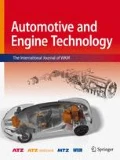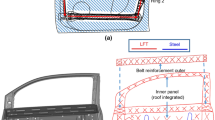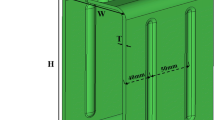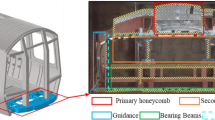Abstract
The objective in the development of passive vehicle safety systems is to protect the occupants in case of an accident. The severity of injuries experienced by the occupants are, among other factors, evaluated based on sensor signals from instrumented dummies in crash tests. Dummy signals, the so-called occupant loads, highly depend on the properties of vehicle structure and restraint systems. These properties need to be defined in very early stages of the development process. To support the engineers in their decision process, different metrics are used to evaluate the vehicle deceleration, the so-called crash pulse. These metrics do not consider the influences of vehicle-specific restraint system properties and can therefore only be used for pulse characterization. They are not suitable to make statements about the expected occupant loads in a crash test. For an efficient design of the passive safety systems, it is important to gain insights on the interaction between vehicle structure and restraint system properties in early stages of the development process. To predict occupant loads based on information, which is available in these early phases, a new method, the Real Occupant Load Criterion for Prediction (ROLC\(_p\)), is presented. By considering the vehicle pulse and specific restraint system properties in its calculation, the ROLC\(_p\) shows good correlation with the dummy’s maximum chest acceleration. As the ROLC\(_p\) can be used in early design phases, it represents a useful tool to improve the current vehicle safety development process.




















Similar content being viewed by others
References
Adolph, T., Eggers, A., Thomson, R., Mizuno, K.: Comparison of the dummy response in two different restraint system crash tests. In: International Research Council on the Biomechanics of Injury Conference, IRCOBI 2014, 10 September 2014 through 12 September 2014, pp. 545–561 (2014)
Boehmlaender, D., Hasirlioglu, S., Yano, V., Lauerer, C., Brandmeier, T., Zimmer, A.: Advantages in crash severity prediction using vehicle to vehicle communication. In: 2015 IEEE International Conference on Dependable Systems and Networks Workshops, pp. 112–117. IEEE (2015)
Böhme, M.: Potentiale passiver Sicherheit in Frontalcrashs: Kopfbelastungen bei geringer und Vorderwagenoptimierung für große Überdeckung, vol. 142. Springer (2019)
Böhmländer, D., Dirndorfer, T., Al-Bayatti, A.H., Brandmeier, T.: Context-aware system for pre-triggering irreversible vehicle safety actuators. Accid. Anal. Prev. 103, 72–84 (2017)
Buck, S.F.: A method of estimation of missing values in multivariate data suitable for use with an electronic computer. J. R. Stat. Soc. Ser. B (Methodol.) 22(2), 302–306 (1960)
Cao, J.Z., Koka, M.R., Law, S.E.: Vehicle pulse shape optimization to improve occupant response in front impact. Tech. rep., SAE Technical Paper (2004)
Crandall, J.R., Cheng, Z., Pilkey, W.: Limiting performance of seat belt systems for the prevention of thoracic injuries. Proc. Inst. Mech. Eng. Part D J. Automob. Eng. 214(2), 127–139 (2000)
Dietterich, T.G., et al.: Ensemble learning. The handbook of brain theory and neural networks 2(1), 110–125 (2002)
Egli, A.: Stopping the occupant of a crashing vehicle-a fundamental study. SAE Transactions, pp. 259–289 (1968)
Eickhoff, B., Gulde, A., GERISCH, P.: Insassensicherheit in kleinfahrzeugen im frontalcrash-eine analyse unter beruecksichtigung unterschiedlicher marktanforderungen, gewichts-und kostenoptimierungsstrategien/safety of small vehicles in frontal crashes-an analysis concerning different market requirements, weight and cost aspects. VDI-Berichte 1 (2078) (2009)
Gabauer, D.J., Gabler, H.C.: Comparison of roadside crash injury metrics using event data recorders. Accid. Anal. Prev. 40(2), 548–558 (2008)
Gildfind, D., Rees, D.: Crash pulse optimisation for minimum occupant harm—a new methodology to calculate fully optimised crash pulses. In: Young Automotive and Transport Executives Conference 2002 (2002)
Grimes, W.D., Lee, F.D.: The effect of crash pulse shape on occupant simulations. Tech. rep., SAE Technical Paper (2000)
Gu, L., Yang, R.J., Li, G., Tyan, T.: Structural optimization for crash pulse. SAE transactions, pp. 786–792 (2005)
Huang, M., Laya, J., Loo, M.: A study on ride-down efficiency and occupant responses in high speed crash tests. Tech. rep., SAE Technical Paper (1995)
Kral, J.: Yet another look at crash pulse analysis. Tech. rep., SAE Technical Paper (2006)
Kübler, L., Gargallo, S., Elsäßer, K.: Characterization and evaluation of frontal crash pulses with respect to occupant safety. In: 9th International Symposium and Exhibition on Sophisticated Car Occupant Safety Systems (2008)
Kübler, L., Gargallo, S., Elsäßer, K.: Frontal crash pulse assessment with application to occupant safety. ATZ Worldwide 111(6), 12–17 (2009)
Langner, W.: Private Communication. Wolfsburg and Weissach (2018–2021)
Le, T.T., Fu, W., Moore, J.H.: Scaling tree-based automated machine learning to biomedical big data with a feature set selector. Bioinformatics 36(1), 250–256 (2020)
Lefer, B., Rebolloso, I.M.: Car-to-truck frontal crash compatibility. Master’s thesis, Chalmers University of Technology/Department of Applied Mechanics (2012)
Lundberg, S.M., Erion, G., Chen, H., DeGrave, A., Prutkin, J.M., Nair, B., Katz, R., Himmelfarb, J., Bansal, N., Lee, S.I.: From local explanations to global understanding with explainable ai for trees. Nat. Mach. Intell. 2(1), 2522–5839 (2020)
Lundberg, S.M., Lee, S.I.: A unified approach to interpreting model predictions. In: Guyon, I., Luxburg, U.V., Bengio, S.H., Wallach, Fergus, R, Vishwanathan, S, Garnett R. (eds.) Advances in Neural Information Processing Systems, vol. 30, pp. 4765–4774. Curran Associates, Inc. (2017). http://papers.nips.cc/paper/7062-a-unified-approach-to-interpreting-model-predictions.pdf
Matsumoto, H., Sakakida, M., Kurimoto, K.: A parametric evaluation of vehicle crash performance. SAE Transactions, pp. 635–646 (1990)
McCullough, C., Hennessey, B.: Nhtsa’s vehicle parameter database and nhtsa’s crash test database. In: Proceedings: International Technical Conference on the Enhanced Safety of Vehicles, vol. 2003, p. 5. National Highway Traffic Safety Administration (2003)
Metzger, J., Kübler, L., Gargallo, S.: Characterization and evaluation of frontal crash pulses for usncap 2011. In: Proceedings Airbag (2010)
Meyer, E.: Understanding injury mechanisms from real world accidents. Master’s thesis. Chalmers University Of Technology (2016)
Molnar, C.: A guide for making black box models explainable (2018). http://christophm.github.io/interpretable-ml-book
NHTSA.: National Highway Traffic Safety Administration vehicle crash test database. License: Public Domain (2021). https://www-nrd.nhtsa.dot.gov/database/veh/
Olson, R.S., Moore, J.H.: Tpot: a tree-based pipeline optimization tool for automating machine learning. In: Workshop on Automatic Machine Learning, pp. 66–74. PMLR (2016)
Park, C.K., Kan, C.: Objective evaluation method of vehicle crash pulse severity in frontal new car assessment program (ncap) tests, pp. 15-0055. Center for Collision Safety and Analysis, George Mason University (2010)
Park, C.K., Kan, C.D.: A study on vehicle crash pulse severity in frontal ncap tests. Tech. rep., SAE Technical Paper (2016)
Park, C.K., Kim, E.Y., Kan, C.D.: Investigation of vehicle crash pulse severity using frontal new car assessment program (ncap) test data. In: ASME International Mechanical Engineering Congress and Exposition, vol. 56420, p. V013T14A042. American Society of Mechanical Engineers (2013)
Picquet, C., Zeitouni, R., Adalian, C.: Parametric study using the olc and spüll to qualify the severity of the full-width rigid test and design an improved front-end. In: 23rd International Technical Conference on the Enhanced Safety of Vehicles (ESV) National Highway Traffic Safety Administration, 13-0442 (2013)
Ribeiro, M.T., Singh, S., Guestrin, C.: “Why should I trust you?”: explaining the predictions of any classifier. In: Proceedings of the 22nd ACM SIGKDD International Conference on Knowledge Discovery and Data Mining, San Francisco, CA, USA, August 13–17, 2016, pp. 1135–1144 (2016)
Sadeghipour, E.: A new approach to assess and optimize the frontal crash compatibility of vehicle structures. Ph.D. thesis, Technische Universität München (2017)
Sadeghipour, E., Fischer, M., Duddeck, F., Lienkamp, M., Ciardiello, R.: Critical review of the current assessment approaches for frontal crash compatibility regarding the evaluation of structural interaction. In: 24th ESV (2015)
Sandner, V., van Ratingen, M., Ellway, J.: Euro ncap-new frontal impact test with mobile progressive deformable barrier (mpdb). In: 26th International Technical Conference on the Enhanced Safety of Vehicles (ESV): Technology: Enabling a Safer Tomorrow National Highway Traffic Safety Administration, 19-0196 (2019)
Shapley, L.S.: 17. A Value for n-Person Games. Princeton University Press, Princeton (2016)
Shi, Y., Wu, J., Nusholtz, G.S.: Optimal frontal vehicle crash pulses-a numerical method for design. In: Proceedings: International Technical Conference on the Enhanced Safety of Vehicles, vol. 2003, p. 15. National Highway Traffic Safety Administration (2003)
Song, S.J., Kim, S., Bilkhu, S.: Front impact pulse severity assessment methodology. Tech. rep., SAE Technical Paper (2005)
Stein, M., Friedemann, D., Eisenach, A., Zimmer, H., Johannsen, H.: Parametric modelling of simplified car models for assessment of frontal impact compatibility. In: 8th LS Dyna User Conference. Strasbourg (2011)
Teng, T.L., Chang, P.H., Liang, C.C., Fung, D.A.: Application of crash pulse on the car crashworthiness design. Adv. Mech. Eng. 9(9), 1687814017700096 (2017)
Tsoi, A.H., Gabler, H.C.: Evaluation of vehicle-based crash severity metrics. Traffic Inj. Prev. 16(sup2), S132–S139 (2015)
Van Buuren, S., Groothuis-Oudshoorn, K.: mice: Multivariate imputation by chained equations in r. J. Stat. Softw. 45(1), 1–67 (2011)
Viano, D.C., Arepally, S.: Assessing the safety performance of occupant restraint systems. SAE Transactions, pp. 1913–1939 (1990)
Wågström, L., Kling, A., Berge, S., Norin, H., Fagerlind, H.: Adaptive structure concept for reduced crash pulse severity in frontal collisions. Int. J. Crashworth. 18(6), 597–605 (2013)
Watson, B., Cronin, D., Campbell, B.: Study of vehicle dynamics and occupant response in side impact crash tests. In: 21st International Technical Conference on the Enhanced Safety of Vehicles (2009)
Werner, S., Carnell, P.: Querying the nhtsa test database for vehicle performance characteristics. Tech. rep., SAE Technical Paper (1994)
Wu, J., Bilkhu, S., Nusholtz, G.S.: An impact pulse-restraint energy relationship and its applications. SAE Transactions, pp. 517–532 (2003)
Wu, J., Nusholtz, G.S., Bilkhu, S.: Optimization of vehicle crash pulses in relative displacement domain. Int. J. Crashworth. 7(4), 397–414 (2002)
Wusk, G., Gabler, H.: Evaluation of vehicle-based crash severity metrics using event data recorders. In: 25th International Technical Conference on the Enhanced Safety of Vehicles (ESV) National Highway Traffic Safety Administration (2017)
Zhang, J., Wang, D., Wu, L.: Assessment approaches of automobile frontal crash pulse. Tech. rep., SAE Technical Paper (2018)
Acknowledgements
We gratefully thank Mr. Werner Langner for his useful advice and many fruitful discussions during this research. We would also like to thank all the students involved in this project for their motivation and dedication, especially Mr. Alvaro Otero and Mr. Steffen Beigang.
Author information
Authors and Affiliations
Corresponding author
Ethics declarations
Conflict of interest
The authors declare that they have no conflict of interest.
Additional information
Publisher's Note
Springer Nature remains neutral with regard to jurisdictional claims in published maps and institutional affiliations.
Annex 1: Input features for the prediction pipeline
Annex 1: Input features for the prediction pipeline
Table 3 provides an overview of all input features describing the vehicle, test setup and restraint system configuration used in the final prediction pipeline (after data preprocessing and feature selection) for the parameters \(x_{1p}\) and \(x_{2p}\).
Rights and permissions
About this article
Cite this article
Rabus, M., Belaid, M.K., Maurer, S.A. et al. Development of a model for the prediction of occupant loads in vehicle crashes: introduction of the Real Occupant Load Criterion for Prediction (ROLC\(_p\)). Automot. Engine Technol. 7, 229–244 (2022). https://doi.org/10.1007/s41104-022-00111-x
Received:
Accepted:
Published:
Issue Date:
DOI: https://doi.org/10.1007/s41104-022-00111-x




